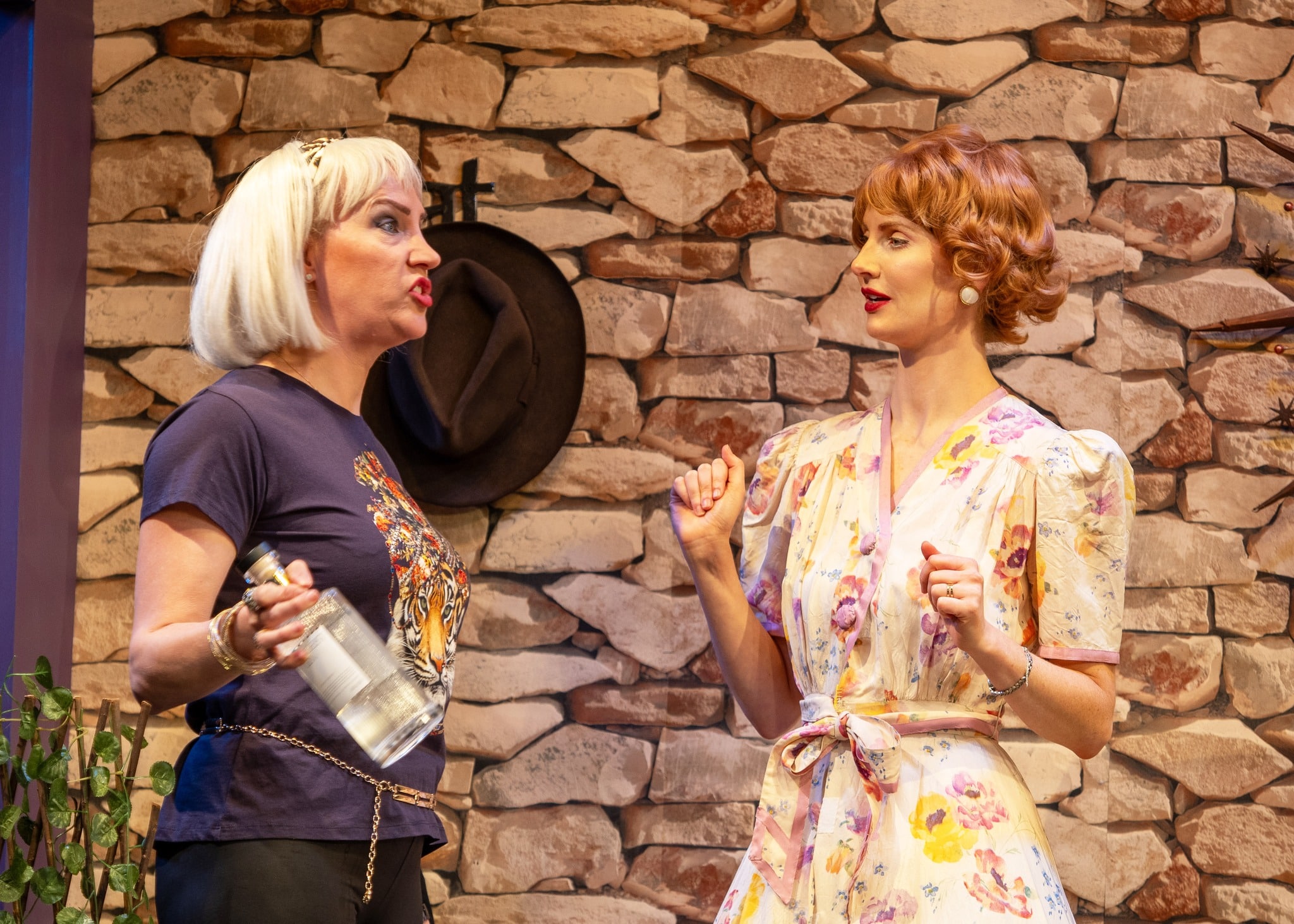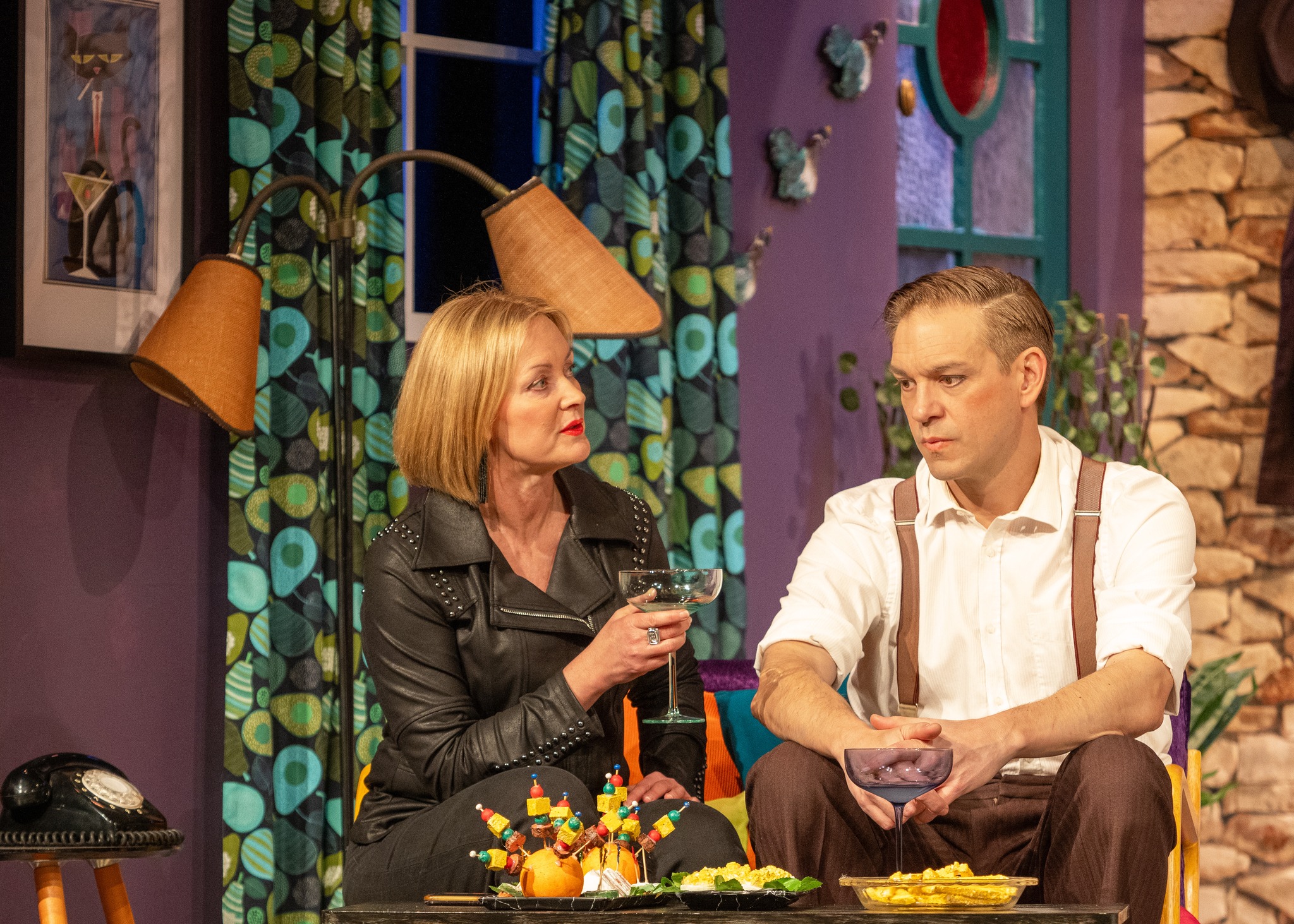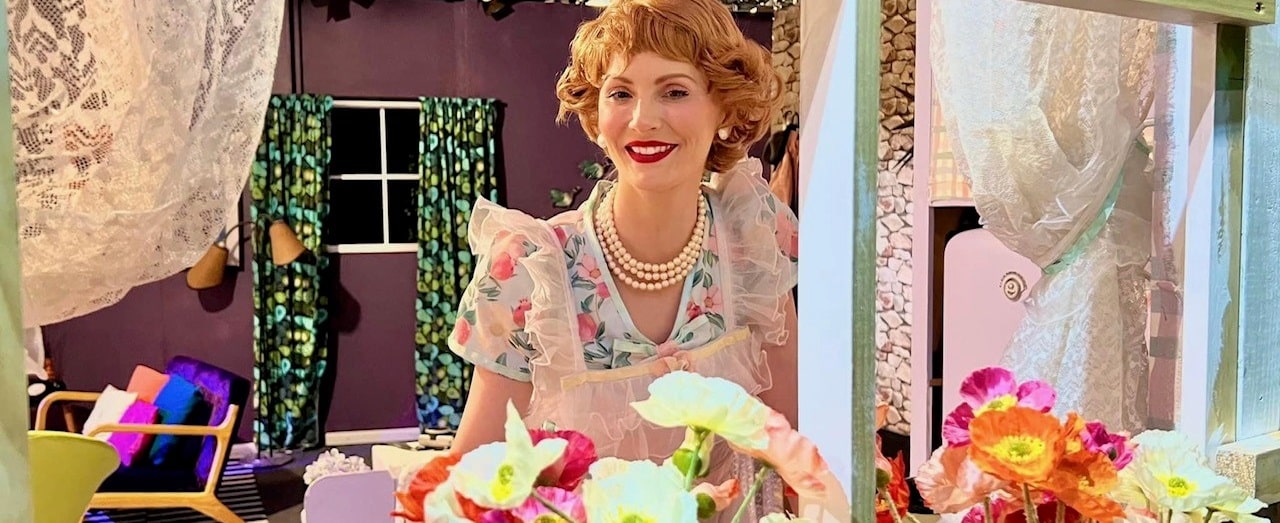Laura Wade’s Olivier Award-winning comedy Home, I’m Darling is simply spiffy!
After finding herself newly free from a high powered job, Judy (Amelia Conway) and her husband Johnny (Daniel Ferris) jointly make a decision to create their own ‘happy place’ – a 1950’s home where Judy revels in keeping a spotless house and greeting her trilby wearing husband at the door with a cocktail and a smile.
Joy Sweeney’s set design of the couple’s living room and pastel paradise kitchen, complete with 50’s everything was charmingly inviting. Kudos to Luke Wallyn, for set construction and to the 12 set builders who were able to make the stage look spacious. The front door being elevated along the back end stage so that the audience could clearly see the entry and exit of characters was a good design; split levels in homes were common at the time.
The opening scene, complete with the gingham wallpaper, white lace billowy kitchen window curtains, boxy lavender refrigerator and oven were tied together to create a fresh background as Judy serves Johnny his toast, tea and eggs. They smile sweetly at each other, bantering about how, as Johnny says, they are “sickeningly happy”, showing their perfect smiles to the audience.
I can almost see them on a television toothpaste advertisement with a ‘Ting’ sound effect, and a bright sparkle appears on Johnny’s tooth when he winks at the audience. This play begins not dissimilar to a sitcom, complete with upbeat 1950’s music that reminds me of Samantha and Darren in Bewitched. Sound design music by Geoff Young and Charlotte Wiltshire were spot on throughout the duration of the play, echoing the character’s moods and expanding the play’s authenticity.
Early on, the audience is first introduced to the fact that this play is not actually set in the 1950’s, but is indeed a created make-believe 1950’s house. When Judy pulls out a laptop from the cupboard after Johnny goes to work, combined later with the loud, sharp and demanding incoming text message sounds from Johnny’s boss Alex’s (Vanessa Merewether) mobile, these modern technologies are completely incongruous with the house’s styling and feels foreign. These instances were lighter and original moments, which the audience appreciated.
Judy and Johnny’s initial wonderfully flowing 1950’s arrangement, told in 2 Acts, unspools as supporting characters enter, and questions are raised as to whether living and abiding by the rules is truely sustainable in the modern world.
Judy’s hippie-looking single mum Sylvia, played by Maxine Appel Cohen, performs a scene stealer with her impassioned speech to Judy and her stylist friend Fran (Cassandra Gorman). She cannot understand why her daughter has chosen to live as a fantasist in a world she has not actually lived through. Judy, (a self confessed Daddy’s girl), is made to listen as her mum talks about how hard she and other women fought to empower women back then, whilst she and other women had to sit quietly with their mouths silenced, turning a blind eye, as their husbands cheated on them.


She continues how the 1950’s were a time where “they were shit for anyone who wasn’t a straight white man”. This powerful speech was truely effective in bringing the audience into a time post-war, where men were number one and women were considered less respected. Sylvia’s realistic interpretation of how women existed to serve their husbands dinner with a smile and lay out their slippers differed from the romanticised version of her daughter.
Amelia Conway skilfully portrayed Judy as the perfect 1950’s domestic goddess housewife, whose flouncy beautiful skirts expanded as she twirled, much like how her smiles fanned out – despite the ongoing financial hardships that she would be forced to confront with Johnny. I noted that amongst all the serving of food, (Judy was a great hostess- preparing devilled eggs and the perfect chocolate cake) whenever her guests or husband ate, Judy did not touch her food. I wondered if this was her character being the polite housewife who didn’t want to gain weight by eating, to “keep her figure trim”? Or if it was not considered polite to eat with her husband, maybe she had to eat afterwards in her version of this world?
Daniel Ferris’ portrayal of Johnny’s unease with the couple’s commitment to the fantasy life of their expected 1950’s roles was excellent. Growing more and more uncomfortable with the stress of him being the sole breadwinner leads to a feeling of being trapped and imprisoned.
Under the direction of Joy Sweeney, Home, I’m Darling incorporates a tightly put together performance which combines the drama of societal expectations of gender roles, misogynistic behaviour in the workplace that happens even now (showed in a scene by Fran’s husband Marcus, played with slimy ickiness by David Eisenhauer) and the question of ever-changing shifts in marriage. Judy’s ‘Who Am I without the 1950’s housewife role’ is inextricably tied to her identity and she and Johnny must learn that if they want their marriage to thrive, a compromise must be sought – together.
This is a thought provoking play which which left me with visions of Judy’s beautiful 1950’s dresses, and an interesting nostalgic feeling, albeit just like Judy, of a picture perfect 1950’s home complete with dial telephones and Formica kitchen bench tops, even though I have never lived it.
Life would certainly have been different then.
Home, I’m Darling is playing at The Theatre on Chester, Chester St Epping
Running Time: 2 hours, including 20 minutes interval
26 July – 17 August 2024
Tickets $30 concession / $35 full
www.theatreonchester.com.au/home-im-darling

